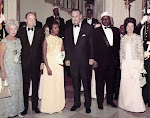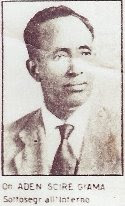The new threats issued by this week from Harakat al Shabaab al Mujahideen, the Movement of Striving Youth in Arabic, include a reference to the United States. Although they are mostly directed at the United Kingdom, they pose an interesting question for American national security analysts: where is the al Qaeda-allied Islamic movement in Somalia going next?
Earlier this year the House Committee on Homeland Security found the United States to be the “primary exporter of Western fighters to al Shabaab” with fifteen Americans killed in fighting there, including America’s first three suicide bombers.
More propaganda than a specific operational command, the series of threatening 140-character messages from #HSMPress, al Shabaab’s English language twitter account, likely reflect a changing face of Somali militancy rather than an elevated threat to the United States or its international partners.
A breakaway faction of the Islamic Courts Union and energized by widely held resentment against the Ethiopian invasion of 2006, al Shabaab has become more internationally focused over time, especially following its public merger with al Qaeda earlier this year. Although the Assistant to the President for Homeland Security and Counter Terrorism, John Brennan, described the move as a “merger between two organizations in decline”, the United States subsequently put bounties on the heads of several al Shabaab leaders, reflecting continuing concerns about the movement’s capabilities.
Al Shabaab historically cut across clan divisions and in recent years has been focused on repelling a Transitional Government for Somalia. It was a radical, youth-based offshoot of the Islamic Courts Union. The latter grew, in a distant echo of the Afghan Taleban, from within communities, in opposition to violent clan-based warlordism and brought a unifying form of Islamic justice to large swathes of the country.
Now it has evolved into two main factions; one with an agenda looking towards global terrorism, led by Mokhtar Ali Zubeyr “Godane”, and a coalition of factions with a Somali Islamist agenda under Sheikh Mukhtar Robow. Often factionalized the most obvious split became evident during the famine last year when Godane’s stance on preventing aid relief into areas of southern Somalia lost the movement Somali support.
As al Shabaab has been pushed out of its homelands, first of Mogadishu and then latterly Kismayo, over the past twelve months, the movement is evolving quickly and somewhat unpredictably. However, an understanding of where al Shabaab has come from historically, the factors at play and the dynamics it is experiencing are a useful insight into where the once pre-eminent Somali Islamist insurgent group is going, but also the future hopes of the Somali people.
The nationalist agenda of al Shabaab, for now, seems ideologically and financially marginalized. The movement lost major sources of funding from inside Somalia after it was forced out of Bakara Market in Mogadishu and then Kismayo port, following operations by Kenyan, Ethiopian and AMISOM forces. To some degree too, a worldwide ban on the import of Somali charcoal and a reportedly diminishing supply of arms from Eritrea have had an impact. It has lost notable leaders recently and lost a useful ally when Hizbul Islam broke away earlier this year.
Cut off from its main historic sources of funding, increasingly factionalized and losing popularity the remaining leaders are looking to prove the movement’s relevance, attract new recruits, including foreign fighters, and source funding in order to survive. The language and message of the tweet regarding Abu Hamza will be lost on many youth in Somalia but makes for an interesting, new lever in bringing potential recruits from the worldwide Somali diaspora into the fold.
Inside Somalia, whether Shabaab is irreversibly retreating or regrouping will only become clear with time. Since the beginning of this year the movement’s fighters have certainly fragmented, leaving for the mountainous areas of Puntland, building stronger ties with groups in Yemen, encouraging extremist groups in Kenya and trying to consolidate their control in the remoter rural areas of Somalia’s south central. One well-known analyst on Somalia sees al Shabaab as knocked down, but not out.
The displacement and changing nature of the threat from al Shabaab will be worrying United States officials. That fighters and munitions are turning up in the relatively stable northern area of Somalia, where there are no African Union troops, may cast a shadow over the military-led, “offshore balancing” strategy, focused on fighting militants in the south of Somalia.
Yet it is further south still, over the border in Kenya’s capital, coast and restive North East province, where there has been the most notable increase in violence, since the Kenya military joined the war in Somalia last year. Kenya may well have the most to lost with an increasingly volatile Islamic movement at its northern porous border and with Presidential elections around the corner. Human Rights Watch logged twenty four attacks, in the majority Somali North East, between October 2011 and February 2012, and the attacks are continuing, provoking violent security clampdowns which risk stoking the fire of radicalization further.
The International Crisis Group has reported on increased radicalization in Kenya and lays out the often missed, powerful demographic, economic and political trends of influence Somalia is having on Kenya. These underlying trends will likely have been at the back of the minds of senior State Department officials as they tried to dissuade the Kenyan government from their risky invasion of Somalia, even years before the plan sprung into action.
Al Shabaab appears to be attempting a strategic adaptation, turning from a conventional fighting force when it fought from a frontline of trenches that divided the capital until August last year to an internationally-focused guerrilla force using more specialized assymetric tactics, including social media to keep itself in the global spotlight. A few recent high-profile suicide attacks on senior Somali government figures were effective in capturing the attention of the world’s media. A campaign of suicide bombings requires more ideological and better trained recruits.
Until only a few years ago, the Islamist movement operated throughout south central Somalia, including controlling most of the the capital. It is too early to tell if the attempt to regroup and ideologically change course are simply the last desperate gasps of a spent force.
However, the unstoppable resurgence of the Taleban in Afghanistan, a movement once thought to be defeated, is a useful reminder to question assumptions and look well beyond the military successes. Many insurgencies have shown themselves to be adaptable, latching on to causes of conflict as they change. Clanism, the absence of socially acceptable and unifying governance and a severely damaged society, that created the violent Islamist movement in the first place, are still present in today’s Somalia. Al Shabaab is only the most obvious and recent manifestation of Somalia’s long-running conflict.
Somalia’s youth and their families will need to continue to feel that they have better lives after al Shabaab’s rule if the movement is to be eradicated forever. With forces from neighboring Kenya and Ethiopia still present in large areas of Somalia and few signs of a notable improvement in basic services and security for the population, time continues to eat away at opportunities to build confidence in the future of the country.via




.jpg)











No comments:
Post a Comment